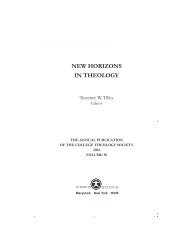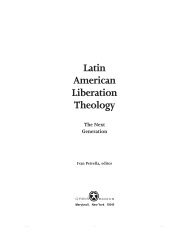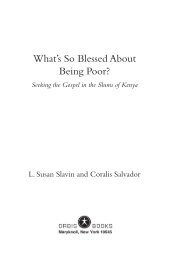CONCEPTS OF MISSION - Orbis Books
CONCEPTS OF MISSION - Orbis Books
CONCEPTS OF MISSION - Orbis Books
Create successful ePaper yourself
Turn your PDF publications into a flip-book with our unique Google optimized e-Paper software.
Mission in Contemporary Missiology 27<br />
ation in the North, where Christianity is struggling anew to recapture its<br />
pristine glory and to make itself understandable to a new generation. This<br />
reality has recently assumed new attention in the writings of some missiologists.<br />
Thus, as already indicated, the challenge rests on reading this new<br />
development from the positive viewpoint of Christian expansion and not as<br />
a displacement of one zone by the other. In addition to this, there is a noticeable<br />
decrease in the number of missionaries from the North Atlantic churches<br />
and a lack of truly missionary spirit. There is also a concern about the continuing<br />
decline in vocations in these zones that were noted for their missionary<br />
enterprise in the Third World countries in the last centuries (see Motte<br />
and Lang 1982, 274). This factor has caused some authors to play down the<br />
missionary urgency and to see the formation of new groups of lay persons as<br />
mission volunteers ad tempus, just as in the social field, as a “sign of the<br />
times.” But the question is: Should the consecrated missionary who before<br />
worked all his life in missions leave the coast clear for the lay person who<br />
commits himself for some years to a rather human task (see López-Gay 1993,<br />
11).<br />
Behind this reality, however, the good news is that the churches in the<br />
global South are today witnessing a great increase in vocations and in the<br />
number of new mission societies. Though apostolic workers in the young<br />
churches are still a minority in proportion to the churches of the North<br />
Atlantic, their increasing numbers are a reality of vitality and of clear growth.<br />
Indeed, the vitality of the young churches is not only a question of numbers<br />
(of workers), but above all of missionary spirit. The missionary spirit remains<br />
active, especially when it is expressed in “missionary departures,” in missionaries<br />
“sent out” to the nations. Also in this field, the young churches seem<br />
to be particularly active (see Dinh Duc Dao 1993, 37-38). The continents of<br />
Africa, Asia, and Latin America, which were often regarded as objects of<br />
mission enterprise, are themselves sending out missionaries. This challenges<br />
the older sister-churches of the North Atlantic to be disposed to receive and<br />
accept missionaries from these young churches as equals and in the spirit of<br />
Pius XII’s encyclical letter Fidei Donum (see nos. 128-139). Therefore,<br />
notwithstanding the actual numerical crisis of missionaries in many churches<br />
of the Northern Hemisphere, one can conclude that God wants and seeks<br />
missionaries. Moreover, God provides the church in every age with the<br />
needed manpower in the missions. Mission is God’s work.<br />
However, the above realities, among others, inspired the so-called theory<br />
of “moratorium” which was proposed by some theologians in the Third<br />
World toward the end of the twentieth century. The theologians called for a<br />
moratorium on foreign missionaries. This theory, which was proposed for<br />
the first time in 1972 in Kenya and is still today the object of discussion in<br />
some circles, was meant to create a kind of pause of about ten years, during<br />
which the young churches were expected to discover their own identities and<br />
develop their own specific character without the control or interference of<br />
foreign missionaries. The theory, which forgets that the particular churches
















